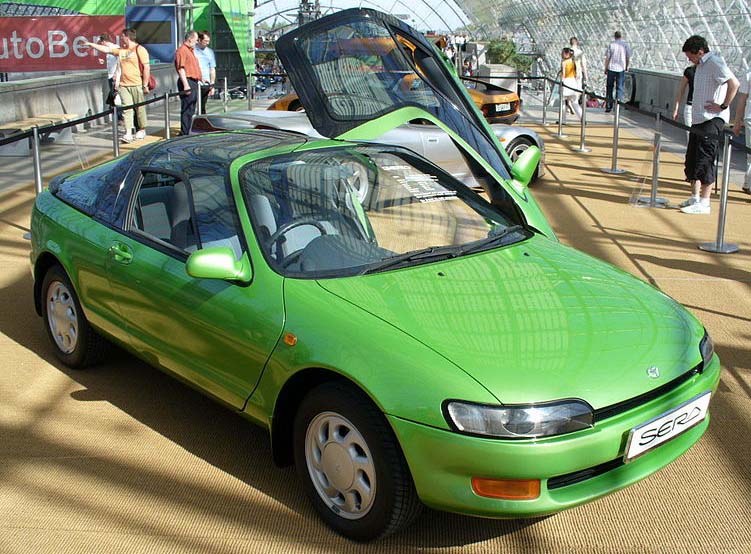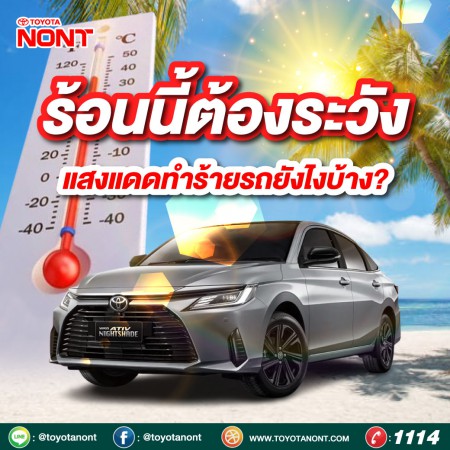

Toyota Sera Part1
The Toyota Sera (model designation EXY10) is a two door, four seat (2+2) coupe built by Toyota from 1990 to 1996. Although produced solely for the Japanese market, it raised interest overseas and has since been imported by car enthusiasts into several countries including Australia, Pakistan, Bangladesh, Canada, India, Ireland, New Zealand, Sri Lanka, Sweden, and the UK. It was initially unveiled in 1988 as the Toyota AXV-II concept car in almost production-ready form. The name comes from the French word meaning "will be" (the French verb "being" in future tense), indicative of both the overall futuristic design and also the closeness of the concept car to the final production version. The Sera is most notable for its butterfly doors which tilt up and forward when opened, and the canopy constructed largely of glass panels.
Base vehicle
As it was released with only one engine and body type there is technically only one model of the Toyota Sera EXY10. However major option choices such as transmission, brakes, cold climate and sound-system meant that there were a number of different factory packages. Furthermore, Toyota itself produced three versions (known as 'Phases') over its production life with specific characteristics (such as interior trim), although variations between the three are largely cosmetic. It was exclusive to Japanese Toyota retail sales channels Toyota Corolla Store.
A total of 15,852 units were built and registered in Japan, however with niche market car importing occurring in the early 1990s it is possible that some vehicles were constructed and exported directly from Japan without first being registered there. This makes it difficult to know exactly how many Seras were produced, although it is certainly less than 16,000 and they are now becoming rare collectibles.
Mechanical
All Seras came with the 1.5 L (1496cc) inline 4 5E-FHE unleaded petrol engine, the largest capacity version of Toyota's E series of engines included in other Toyota vehicles such as the Paseo and the Starlet. This was installed in a front-mount, front wheel drive transverse configuration with electronic fuel injection. All versions came with power assisted rack and pinion steering and either a 4 speed automatic or 5 speed manual transmission. The brakes were vented discs at the front and drums at the rear, unless fitted with the optional Anti-Lock Braking system which had vented discs all round.
Mechanically the car is related to both the Toyota Paseo and the Toyota Starlet, sharing similar floorpans, suspension, steering and brakes amongst other items. As such, many consumable parts such as brakepads and springs are interchangeable and still readily available from parts suppliers.
Body
The Toyota Sera is of a steel monocoque construction with a low and rounded body shape. It is a two door plus hatch (sometimes referred to as three door or hatchback) coupe. The Sera's most distinctive feature is its butterfly doors, which are hinged at the top and bottom of the A pillar and open forward and up in a manner similar to the McLaren F1 and Saleen S7 - the McLaren F1 designer Gordon Murray cited the Sera as the inspiration of the F1's door arrangement.[1] The weight of the door is predominantly supported by a thick gas strut, and counterbalanced by a smaller secondary strut inside the door to help take into account changes in temperature. With age these struts can lose pressure causing the doors to sag or fail to stay open, however the issue can be resolved by re-gassing or replacing the strut. Unlike the conventional side-opening doors on most cars, the Sera door can be opened fully in a fairly confined space, requiring only 43 cm of lateral clearance.
The rear hatch is also unusual in being constructed of a single piece of glass without a supporting steel frame. This, in combination with a steeply sloping front windscreen and glass upper-door/roof panels (a total of six separate glass pieces overall), gives the Sera its characteristic "bubble-like" canopy. This provides occupants with a high level of all-round visibility, although the thick B-pillar can result in a significant blind spot, especially on the driver's side. The unusual amount of glass can also create a high solar load greenhouse effect on bright days causing the interior temperature to rise. This problem however is offset by the fact that the Toyota Sera came with both air-conditioning and two removable interior roof panels as standard.
As with other cars (such as convertibles) where the upper half has little or no supporting framework, the Sera body is not necessarily as rigid as fixed roof vehicles. This can result in a certain amount of body roll while manoeuvring, although this can also be in part attributed to the overall age of the vehicle and components such as suspension.
Interior
The Toyota Sera is a 2+2 coupe with bucket seats at the front and a rear bench seat with a fixed central arm rest. Both front seats tilt and slide forward to give access to the rear and although the interior is quite compact the deep, form-fitting design of the rear seats means the vehicle can provide space (albeit cramped) in the back for passengers of average height. The front seats in all versions came with three point harnesses while the rear seats came with either two point lap sashes or three-point harnesses depending on the Phase. It is in the specifics of the interior that the majority of the differences in Phases occurs as outlined below.
In its normal interior configuration (with the back seats up and the parcel shelf in place) the rear cargo area does have a noticeably small opening (52 cm by 82 cm) and an elevated lip necessitating the lifting of luggage quite high before it can be placed inside. However the boot (trunk) is relatively deep and spacious. In addition the rear seats fold down and both the parcel shelf and the rear divider panel (usually in place behind the back seats) can be completely removed, in essence turning the entire rear half of the car into a cargo area. As such the Toyota Sera has a large amount of available storage space for its size. The space-saving spare tire and changing kit are contained in a small compartment below the boot floor.
The Sera/EXY-10 was one of the first cars to feature projector headlights (though the 1988 AXV-II concept model featured conventional lights). The Alfa Romeo Stradale is believed to be the first car to feature dihedral doors which, like the Sera, features windows that curve upward into the 'roof' section of the vehicle.








